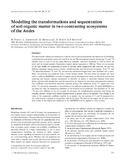Modelling the transformations and sequestration of soil organic matter in two contrasting ecosystems of the Andes
Fecha
2007-06Metadatos
Mostrar el registro completo del ítemResumen
The mechanisms linking soil respiration to climate and soil physical properties are important for modelling transformation and sequestration of C and N in the soil. We investigated them by incubating 14C and 15N labelled straw in soils of the dry puna (Bolivian altiplano, semi-arid shrubland at 3789 m above sea level) and the humid paramo (Venezuelan tropical alpine vegetation at 3400 m). These two ecosystems of the high Andes are comparable in terms of altitude, mean temperature and land use, but are very different regarding organic matter content, rainfall patterns and soil physical properties. Total 14C and 15N, microbial-biomass 14C and 15N, soil moisture and meteorological data were recorded over 2 years. Daily soil moisture was predicted from a water balance model. The data from the paramo site were used to calibrate MOMOS-6, a model of organic matter decomposition based on microbial activity and requiring only kinetic constant parameters to describe: (i) inputs to microbial biomass from plant debris and microbial metabolites, and (ii) losses from the biomass by mortality and respiration (respiration coefficient and microbial metabolic quotient qCO2). The simulated qCO2–14C agrees well with qCO2–14C and qCO2 measured at the calibration site and with published data. To apply MOMOS-6 to the puna site, only the respiration coefficient of the biomass was re-estimated. The dynamics of 14C and 15N were very different in the two systems. In the puna, the transformation processes stop during the long dry periods, though total annual mineralization is greater than in the paramo. The change in the value of the respiration coefficient enables us to predict that the amount of C and N sequestered in the stable humus is greater in the paramo than in the puna. The data in this paper can be used to estimate values of the respiration coefficient so that MOMOS-6 can be applied to other systems.
Colecciones
Información Adicional
| Correo Electrónico | pansu@mpl.ird.fr lsarmien@ula.ve |
| Editor | European Journal of Soil Science 58(3): 775-785 |
| Colación | 775-785. |
| País | Europa |
| Institución | Universidad de Los Andes |






